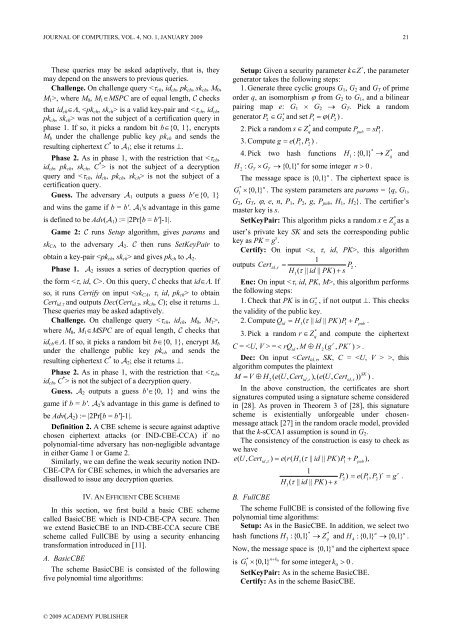Constructing Efficient Certificate-based Encryption with Paring
Constructing Efficient Certificate-based Encryption with Paring
Constructing Efficient Certificate-based Encryption with Paring
Create successful ePaper yourself
Turn your PDF publications into a flip-book with our unique Google optimized e-Paper software.
JOURNAL OF COMPUTERS, VOL. 4, NO. 1, JANUARY 2009 21These queries may be asked adaptively, that is, theymay depend on the answers to previous queries.Challenge. On challenge query < ch , id ch , pk ch , sk ch , M 0 ,M 1 >, where M 0 , M 1 MSPC are of equal length, checksthat id ch , is a valid key-pair and < ch , id ch ,pk ch , sk ch > was not the subject of a certification query inphase 1. If so, it picks a random bit b{0, 1}, encryptsM b under the challenge public key pk ch and sends theresulting ciphertext C * to 1 ; else it returns .Phase 2. As in phase 1, <strong>with</strong> the restriction that < ch ,id ch , pk ch , sk ch , C * > is not the subject of a decryptionquery and < ch , id ch , pk ch , sk ch > is not the subject of acertification query.Guess. The adversary 1 outputs a guess b'{0, 1}and wins the game if b = b'. 1 's advantage in this gameis defined to be Adv( 1 ) := |2Pr[b = b']-1|.Game 2: runs Setup algorithm, gives params andsk CA to the adversary 2 . then runs SetKeyPair toobtain a key-pair and gives pk ch to 2 .Phase 1. 2 issues a series of decryption queries ofthe form . On this query, checks that id. Ifso, it runs Certify on input to obtainCert id, and outputs Dec(Cert id, , sk ch , C); else it returns .These queries may be asked adaptively.Challenge. On challenge query < ch , id ch , M 0 , M 1 >,where M 0 , M 1 MSPC are of equal length, checks thatid ch . If so, it picks a random bit b{0, 1}, encrypt M bunder the challenge public key pk ch and sends theresulting ciphertext C * to 2 ; else it returns .Phase 2. As in phase 1, <strong>with</strong> the restriction that < ch ,id ch , C * > is not the subject of a decryption query.Guess. 2 outputs a guess b'{0, 1} and wins thegame if b = b'. 2 's advantage in this game is defined tobe Adv( 2 ) := |2Pr[b = b']-1|.Definition 2. A CBE scheme is secure against adaptivechosen ciphertext attacks (or IND-CBE-CCA) if nopolynomial-time adversary has non-negligible advantagein either Game 1 or Game 2.Similarly, we can define the weak security notion IND-CBE-CPA for CBE schemes, in which the adversaries aredisallowed to issue any decryption queries.IV. AN EFFICIENT CBE SCHEMEIn this section, we first build a basic CBE schemecalled BasicCBE which is IND-CBE-CPA secure. Thenwe extend BasicCBE to an IND-CBE-CCA secure CBEscheme called FullCBE by using a security enhancingtransformation introduced in [11].A. BasicCBEThe scheme BasicCBE is consisted of the followingfive polynomial time algorithms:Setup: Given a security parameter kZ + , the parametergenerator takes the following steps:1. Generate three cyclic groups G 1 , G 2 and G T of primeorder q, an isomorphism from G 2 to G 1 , and a bilinearpairing map e: G 1 G 2 G T . Pick a randomgenerator P 2 G 2and set P1 ( P2).*2. Pick a random s Z qand compute Ppub sP1.3. Compute g eP (1, P2).*4. Pick two hash functions :{0,1} *H1 Zqand: { nH2 GTGT 0,1} for some integer n 0 .The message space is {0,1} n . The ciphertext space is*G1 {0,1} n . The system parameters are params = {q, G1,G 2 , G T , , e, n, P 1 , P 2 , g, P pub , H 1 , H 2 }. The certifier’smaster key is s.*SetKeyPair: This algorithm picks a random x Z qas auser’s private key SK and sets the corresponding publickey as PK = g x .Certify: On input , this algorithm1outputs Certid, P2.H1( || id || PK) sEnc: On input , this algorithm performsthe following steps:1. Check that PK is in G 2, if not output . This checksthe validity of the public key.2. Compute Qid H1( || id || PK)P1 Ppub.*3. Pick a random rZ qand compute the ciphertextC = = ,2( r r rQidM H g , PK ) .Dec: On input , thisalgorithm computes the plaintextSKM V H2 (( e U, Certid, ),(( e U, Certid, )) ).In the above construction, the certificates are shortsignatures computed using a signature scheme consideredin [28]. As proven in Theorem 3 of [28], this signaturescheme is existentially unforgeable under chosenmessageattack [27] in the random oracle model, providedthat the k-sCCA1 assumption is sound in G 2 .The consistency of the construction is easy to check aswe haveeU ( , Certid, ) er ( ( H1( || id|| PK) P1Ppub),1P2) eP (1, P2) r gr .H ( || id || PK) s1B. FullCBEThe scheme FullCBE is consisted of the following fivepolynomial time algorithms:Setup: As in the BasicCBE. In addition, we select two*hash functions :{0,1} *nnH3 Zqand H4:{0,1} {0,1} .Now, the message space is {0,1} n and the ciphertext space*0is G 1{0,1} n kfor some integer k0 0 .SetKeyPair: As in the scheme BasicCBE.Certify: As in the scheme BasicCBE.© 2009 ACADEMY PUBLISHER
















